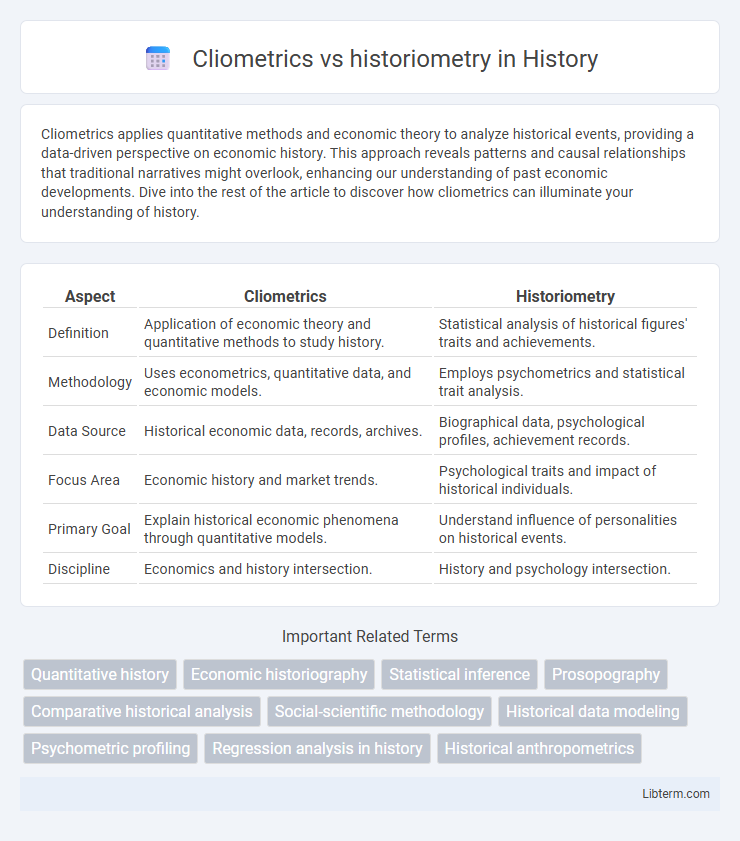Cliometrics applies quantitative methods and economic theory to analyze historical events, providing a data-driven perspective on economic history. This approach reveals patterns and causal relationships that traditional narratives might overlook, enhancing our understanding of past economic developments. Dive into the rest of the article to discover how cliometrics can illuminate your understanding of history.
Table of Comparison
| Aspect | Cliometrics | Historiometry |
|---|---|---|
| Definition | Application of economic theory and quantitative methods to study history. | Statistical analysis of historical figures' traits and achievements. |
| Methodology | Uses econometrics, quantitative data, and economic models. | Employs psychometrics and statistical trait analysis. |
| Data Source | Historical economic data, records, archives. | Biographical data, psychological profiles, achievement records. |
| Focus Area | Economic history and market trends. | Psychological traits and impact of historical individuals. |
| Primary Goal | Explain historical economic phenomena through quantitative models. | Understand influence of personalities on historical events. |
| Discipline | Economics and history intersection. | History and psychology intersection. |
Introduction to Cliometrics and Historiometry
Cliometrics applies economic theory, statistical methods, and quantitative data to analyze historical events, focusing on measurable economic patterns and behaviors. Historiometry employs quantitative techniques to assess historical figures' psychological traits and influence, often using biographical and archival data for analysis. Both fields utilize statistical tools but differ in their emphasis: Cliometrics centers on economic history and quantitative economic modeling, while Historiometry emphasizes psychological measurement and historical personality assessment.
Defining Cliometrics: Quantitative History
Cliometrics, also known as quantitative history, employs statistical methods and economic theory to analyze historical data, transforming qualitative narratives into measurable variables. This approach uses econometric models to test hypotheses about economic and social phenomena in historical contexts. Unlike historiometry, which focuses on the quantitative measurement of individual characteristics and achievements, cliometrics emphasizes broader economic patterns and long-term historical trends.
Understanding Historiometry: Measuring Historical Greatness
Historiometry applies statistical analysis and quantitative methods to evaluate historical figures' greatness by examining achievements, influence, and impact over time. Unlike cliometrics, which emphasizes economic history through econometric modeling and quantitative data analysis, historiometry incorporates psychological assessments and archival data to measure traits like creativity and leadership. This approach quantifies subjective aspects of historical legacy, providing a structured framework for comparing greatness across diverse historical contexts.
Methodological Differences
Cliometrics employs quantitative methods, such as econometric models and statistical analysis, to interpret historical economic data objectively. Historiometry relies on qualitative techniques, including biographical analysis and psychometric assessment, to evaluate historical figures' psychological traits and decision-making processes. These methodological differences highlight cliometrics' emphasis on data-driven economic patterns versus historiometry's focus on individual behavioral insights within historical contexts.
Data Sources and Tools Employed
Cliometrics relies heavily on quantitative data such as historical economic records, census data, and price indexes, utilizing statistical software and econometric models to analyze trends and economic behavior over time. Historiometry employs biographical databases, archival materials, and psychological assessments, often using qualitative analysis tools and psychometric techniques to explore individual historical figures' traits and societal impact. The distinction lies in cliometrics' emphasis on numerical datasets and econometric tools versus historiometry's focus on qualitative data and psychological measurement instruments.
Major Applications in Historical Research
Cliometrics employs quantitative methods and economic theory to analyze historical data, primarily focusing on economic history, labor markets, and demographic changes through statistical modeling. Historiometry applies psychological measurement and statistical analysis to historical figures, emphasizing leadership studies, biography analysis, and the assessment of individual traits' impact on historical events. Both approaches enhance historical research by providing empirical evidence and rigorous analysis but differ in their primary focus--Cliometrics centers on broad socioeconomic trends, while historiometry concentrates on individual behaviors and personality metrics.
Key Figures and Theoretical Foundations
Cliometrics is closely associated with economists like Robert Fogel and Douglass North, who introduced quantitative methods to economic history grounded in neoclassical economic theory and rational choice models. Historiometry, pioneered by Lewis Terman and later advanced by Dean Keith Simonton, applies statistical techniques to historical data on individuals' psychological traits, incorporating theories from psychometrics and personality psychology. Both fields rely on empirical analysis but differ in their theoretical foundations: cliometrics emphasizes economic theory and formal modeling, while historiometry focuses on psychological theories and individual differences.
Strengths and Limitations of Each Approach
Cliometrics leverages quantitative methods and economic theory to analyze historical data, offering precise measurement of economic patterns but often struggles with incomplete or biased datasets. Historiometry applies statistical analysis to biographical and historical records to quantify psychological traits and leadership qualities, providing deep insights into individual behavior yet facing challenges in data subjectivity and interpretative consistency. Each approach complements the other's limitations by combining rigorous quantitative analysis with qualitative contextual understanding.
Interdisciplinary Influence and Academic Reception
Cliometrics, integrating economic theory and quantitative methods, has profoundly influenced economics, history, and social sciences by providing empirical rigor to historical analysis. Historiometry, combining psychology, statistics, and biography, has shaped fields like leadership studies and creativity research through quantitative evaluation of historical figures. Academic reception of cliometrics is generally favorable in economics and history departments, while historiometry often sparks debate over methodological validity in psychological and historical scholarship.
Future Trends in Historical Quantitative Analysis
Future trends in historical quantitative analysis emphasize the integration of cliometrics and historiometry through advanced machine learning algorithms and enhanced data visualization techniques. Embracing large-scale digitized archives and improved computational power enables researchers to uncover nuanced patterns in economic and social history with greater precision. The fusion of cliometrics' economic models and historiometry's psychological metrics promises richer, multidimensional insights into historical phenomena.
Cliometrics Infographic

 libterm.com
libterm.com